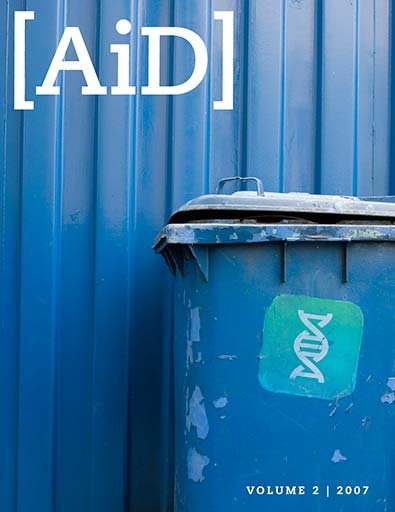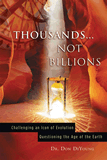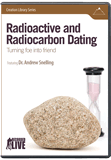
Radioisotopes and the Age of the Earth
Abstract
The RATE research project demonstrated that creationists could support a larger-scale collaborative research effort, particularly if it delivered significant breakthroughs on a key challenging issues.
Keywords: radioisotopes, age of the earth, RATE, Institute for Creation Research, Creation Research Society, fission tracks, radiohalos, radioisotope, dating methods, radiocarbon, carbon-14, decay
The 1997–2005 RATE (Radioisotopes and the Age of the Earth) research project at the Institute for Creation Research (co-sponsored by the Creation Research Society) demonstrated that creationists could support a larger-scale collaborative research effort, particularly if it delivered significant breakthroughs on a key challenging issue. The primary focus of this research effort was the radioactive methods for dating rocks that supposedly yield age estimates of millions and billions of years and thus provide support for the claimed multi-billion year age for the earth. The research team assembled for this project included:
- Larry Vardiman, Ph.D. Atmospheric Science (project co-ordinator)
- D. Russell Humphreys, Ph.D. Physics (helium diffusion)
- Eugene F. Chaffin, Ph.D. Physics (theoretical models)
- Donald DeYoung, Ph.D. Physics
- John R. Baumgardner, Ph.D. Geophysics (radiocarbon)
- Steven A. Austin, Ph.D. Geology (rock dating)
- Andrew A. Snelling, Ph.D. Geology (rock dating, fission tracks, radiohalos)
- Steven W. Boyd, Ph.D. Hebraic and Cognate Studies (Genesis 1 text)
There were numerous significant outcomes from this project:
- There is visible physical evidence in rocks, namely, fission tracks and radiohalos, that a lot of nuclear decay has occurred through earth history. Uranium atoms decay in two ways. Some uranium atoms spontaneously break apart (split or fission) into two smaller atoms. The energy of this fission process causes the two smaller atoms to fly apart, leaving observable linear scars called fission tracks in the host minerals that can be seen under a microscope. In most other uranium atoms, the size of their nuclei makes them unstable, and so, radiation particles called alpha-particles are ejected from them. These alpha-particles are like little “bullets” that damage the host minerals leaving physical scars. Because the alpha-particles are ejected in all directions from around where the uranium atoms are concentrated, the result seen in cross section is a halo of visible physical damage which can be seen under a microscope. These are called radioactive halos, abbreviated to “radiohalos.” Some minerals from many levels in the geologic record were found to have high concentrations of fission tracks and numerous radiohalos consistent with much nuclear decay having occurred, equivalent to hundreds of millions of years worth of decay at today’s slow rates. This would suggest that, because the Bible indicates the earth is young (about 6,000 years old), this large quantity of nuclear decay must have occurred at much faster rates than those measured today.
- There are often systematic differences in the radioisotope age estimates provided by the four main radioactive dating methods from the same samples of rock units. Unstable parent atoms decay into daughter atoms of different elements, so measuring quantities of parent and daughter atoms in rocks and minerals, and knowing the rates at which this decay occurs, enables the calculation of when the decay process began in that rock or mineral, which is then deemed its age estimate. An example of the results obtained is provided by the rock layer of volcanic origin at Bass Rapids in the Grand Canyon, which yielded the following age estimates:
- 841.5 million years (potassium-argon)
- 1,060 million years (rubidium-strontium)
- 1,250 million years (uranium-lead)
- 1,379 million years (samarium-neodymium)
- There is evidence that nuclear decay rates were grossly accelerated during a recent catastrophic episode or episodes. They are the systematic differences in radioisotope age estimates for the same rock units, as explained in item two above, which can only be reconciled by grossly accelerated decay rates in the past. There are co-existing uranium and polonium radiohalos in the same mineral grains in granites from around the world. Because polonium has a fleeting existence, the polonium radiohalos had to have formed within hours and days. However, the source of the polonium had to be the uranium which was also at the same time producing the uranium radiohalos. So, the uranium had to be decaying extremely rapidly to supply sufficient polonium quickly enough to form the adjacent polonium radiohalos. And finally, helium gas is a by-product of the radioactive decay of uranium within minerals. However, this helium gas easily leaks out of the host minerals. Thus two age estimates can be calculated for these mineral grains—one based on radioactive decay of uranium to lead, and the other based on the rate at which the helium leaks out of the mineral grains. For certain mineral crystals it was found the uranium-lead radioactive age estimate was 1.5 billion years, yet the helium leak age was only about 6,000 years. Because the latter is based on experimentally verified physical laws, it can be concluded that a tremendous amount of radioactive decay (which would take 1.5 billion years at today's decay rates) must have occurred catastrophically during some event in the last 6,000 years!
- There are significant detectable levels of radiocarbon (carbon-14) intrinsic within ancient coal and diamonds. Samples from coal layers conventionally “dated” at 40–320 million years old all yielded radiocarbon age estimates of around 50,000 years, implying that they were all deposited recently, at the same time and in the same event. Interestingly, diamonds conventionally dated at 1–2 billion years old gave only slightly older radiocarbon age estimates. When it is considered that radiocarbon levels and production rates were different in the past, these radiocarbon age estimates for these coal layers and diamonds are direct evidence of a young earth.
- The mechanisms associated with how radioactive decay occurs within the nuclei of the parent atoms—when theoretically adjusted—change decay rates. Very tiny adjustments to the nuclear forces could produce very large changes in decay rates. It is realized that changes in fundamental constants, and also greatly accelerated nuclear decay, are radical suggestions.
- The Hebrew verb forms used in the Genesis 1:1–2:3 creation account were compared with those used in other Old Testament passages that all are agreed are either narrative or poetic. The text of the Genesis 1:1–2:3 creation account was thus emphatically shown to be a narrative, to be read literally like any other historical account.
Because of the RATE research results, the long-age radioactive methods for dating rocks can now be more easily demonstrated to often be faulty, since there are problems with the three crucial assumptions on which they are based:
- There are uncertainties as to the absence or presence of daughter atoms when the rocks formed, because there is much evidence of the rocks having inherited daughter atoms that were not formed by radioactive decay in those rocks.
- There is abundant evidence of widespread “open-system” behavior of parent and daughter atoms. Rocks are often contaminated with extra parent and daughter atoms produced apart from radioactive decay. Parent and daughter atoms are also removed by various geologic processes (for example, leaching by fluids) subsequent to the rocks forming.
- Nuclear decay rates may well have changed in the past.
Much research, even reported in the conventional scientific literature, has found that rocks of known age often yield erroneously old radioactive age estimates because either one of the first two assumptions, or both, can be demonstrated to be false. And if the radioactive “clocks” have not always “ticked” at the currently measured slow rates but were grossly accelerated in the past, then these radioactive dating methods cannot be used to provide reliable age estimates for rocks. After all, if these “clocks” don’t work on rocks of known ages, how can they be trusted on rocks of unknown ages? To be sure, there is a systematic trend of radioactive age estimates for rocks according to their positions in the geologic record, but this would be expected if nuclear decay was grossly accelerated systematically when the rock layers were forming. For example, rocks laid down early in the Flood would yield older ages than rocks laid down later during the Flood because the earlier rocks would have experienced more accelerated radioactive decay.
For More Information:
Layman-level Articles:
- J. R. Baumgardner, “Carbon Dating Undercuts Evolution’s Long Ages,” Impact 364 (2003).
- S. W. Boyd, “The Biblical Hebrew Creation Account: New Numbers Tell the Story,” Impact 377 (2004).
- D. R. Humphreys, “Nuclear Decay: Evidence for a Young World,” Impact 352 (2002).
- D. R. Humphreys, “New RATE Data Support a Young World,” Impact 366 (2003).
- D. R. Humphreys, “A Tale of Two Hourglasses,” Impact 402 (2006).
- M. Riddle, “Doesn’t Carbon-14 Dating Disprove the Bible?,” in The New Answers Book, ed. K.A. Ham (Green Forest, Arkansas: Master Books, 2006), pp. 77–87.
- M. Riddle, “Does Radiometric Dating Prove the Earth Is Old?,” in The New Answers Book, ed. K.A. Ham (Green Forest, Arkansas: Master Books, 2006), pp. 113–124.
- A. A. Snelling, “Radioactive ‘dating’ failure,” Creation 22.1, 1999, pp. 18–21.
- A. A. Snelling, “‘Excess Argon’: The ‘Achilles’ Heel’ of Potassium-Argon and Argon-Argon ‘Dating’ of Volcanic Rocks,” Impact 307 (1999).
- A. A. Snelling, “Potassium-Argon and Argon-Argon Dating of Crustal Rocks and the Problem of Excess Argon,” Impact 309 (1999).
- A. A. Snelling, “Dubious Radiogenic Pb Behavior Places U-Th-Pb Mineral Dating in Doubt,” Impact 319 (2000).
- A. A. Snelling, “Polonium Radiohalos: Still ‘a Very Tiny Mystery’,” Impact 326 (2000).
- A. A. Snelling, “Radiohalos—Significant and Exciting Research Results,” Impact 353 (2002).
- A. A. Snelling, “Radioisotope Dating of Grand Canyon Rocks: Another Devastating Failure for Long-age Geology,” Impact 376 (2004).
- A. A. Snelling, “Polonium Radiohalos: The Model for Their Formation Tested and Verified,” Impact 386 (2005).
- A. A. Snelling, “Radioisotope dating of rocks in the Grand Canyon: A devastating failure for long-age geology,” Creation 27.3, 2005, pp. 44–49.
- A.A. Snelling, “The Fallacies of Radioactive Dating of Rocks,” Answers 1.1, Fall 2006, pp. 66–69.
- A.A. Snelling, “Radiohalos: Startling evidence of catastrophic geologic processes on a young earth,” Creation 28.2, 2006, pp. 46–50.
Technical Papers
- S. A. Austin and A. A. Snelling, “Discordant Potassium-Argon Model and Isochron ‘Ages’ for Cardenas Basalt (Middle Proterozoic) and Associated Diabase of Eastern Grand Canyon, Arizona,” in Proceedings of the Fourth International Conference on Creationism, ed. R. E. Walsh (Pittsburgh, Pennsylvania: Creation Science Fellowship, 1998), pp. 35–51.
- J. R. Baumgardner, A. A. Snelling, D. R. Humphreys and S. A. Austin, “Measurable 14C in Fossilized Organic Materials: Confirming the Young Earth Creation-Flood Model” [PDF], in Proceedings of the Fifth International Conference on Creationism, ed. R. L. Ivey, Jr. (Pittsburgh, Pennsylvania: Creation Science Fellowship, 2003), pp. 127–142.
- E. F. Chaffin, “A Mechanism for Accelerated Radioactive Decay,” Creation Research Society Quarterly Journal 37.1, June 2000, pp. 3–9.
- E.F. Chaffin, “Accelerated Decay: Theoretical Models” [PDF], in Proceedings of the Fifth International Conference on Creationism, ed. R. L. Ivey, Jr. (Pittsburgh, Pennsylvania: Creation Science Fellowship, 2003), pp. 3–15.
- D. R. Humphreys, S. A. Austin, J. R. Baumgardner and A. A. Snelling, “Helium Diffusion Rates Support Accelerated Nuclear Decay” [PDF], in Proceedings of the Fifth International Conference on Creationism, ed. R. L. Ivey, Jr. (Pittsburgh, Pennsylvania: Creation Science Fellowship, 2003), pp. 175–195.
- D.R. Humphreys, S.A. Austin, J.R. Baumgardner and A.A. Snelling, “Helium Diffusion Age of 6,000 Years Supports Accelerated Nuclear Decay,” Creation Research Society Quarterly Journal 41.1, June 2004, pp. 1–16.
- A. A. Snelling, “The Cause of Anomalous Potassium-Argon Ages for Recent Andesite Flows at Mt. Ngauruhoe, New Zealand, and the Implications for Potassium-Argon Dating,” in Proceedings of the Fourth International Conference on Creationism, ed. R. E. Walsh (Pittsburgh, Pennsylvania: Creation Science Fellowship, 1998), pp. 503–525.
- A. A. Snelling, “The Relevance of Rb-Sr, Sm-Nd and Pb-Pb Isotope Systematics to Elucidation of the Genesis and History of Recent Andesite Flows at Mt. Ngauruhoe, New Zealand, and the Implications for Radioisotopic Dating” [PDF], in Proceedings of the Fifth International Conference on Creationism, ed. R. L. Ivey, Jr. (Pittsburgh, Pennsylvania: Creation Science Fellowship, 2003), pp. 285–303.
- A. A. Snelling, “Whole-rock K-Ar Model and Isochron, and Rb-Sr and Pb-Pb Isochron, ‘Dating’ of the Somerset Dam Layered Mafic Intrusion, Australia” [PDF], in Proceedings of the Fifth International Conference on Creationism, ed. R. L. Ivey, Jr. (Pittsburgh, Pennsylvania: Creation Science Fellowship, 2003), pp. 305–324.
- A. A. Snelling and M. H. Armitage, “Radiohalos—A Tale of Three Granitic Plutons” [PDF], in Proceedings of the Fifth International Conference on Creationism, ed. R. L. Ivey, Jr. (Pittsburgh, Pennsylvania: Creation Science Fellowship, 2003), pp. 243–267.
- A. A. Snelling, S. A. Austin and W. A. Hoesch, “Radioisotopes in the Diabase Sill (Upper Precambrian) at Bass Rapids, Grand Canyon, Arizona: An Application and Test of the Isochron Dating Method” [PDF], in Proceedings of the Fifth International Conference on Creationism, ed. R. L. Ivey, Jr. (Pittsburgh, Pennsylvania: Creation Science Fellowship, 2003), pp. 269–284.
- L. Vardiman, S. A. Austin, J. R. Baumgardner, E. F. Chaffin, D. B. DeYoung, D. R. Humphreys, and A. A. Snelling, “Radioisotopes and the Age of the Earth” [PDF], in Proceedings of the Fifth International Conference on Creationism, ed. R. L. Ivey, Jr. (Pittsburgh, Pennsylvania: Creation Science Fellowship, 2003), pp. 337–348.
Layman-level Books
- D. B. DeYoung, Thousands ... not Billions: Challenging an Icon of Evolution, Questioning the Age of the Earth, (Green Forest, Arkansas: Master Books, 2005).
DVDs
- S. A. Austin, Radioisotopes and the Age of the Earth, (Petersburg, Kentucky: Answers in Genesis, 2003).
- D. R. Humphreys, Helium Leaks Show the Earth is Young, (Petersburg, Kentucky: Answers in Genesis, 2007).
- L. Vardiman, Rocks of Ages or Rock of Creation? (Petersburg, Kentucky: Answers in Genesis, 2003).
- D. B. DeYoung, Thousands ... not Billions: Challenging an Icon of Evolution, Questioning the Age of the Earth, (Santee, California: Institute for Creation Research, 2005).
- L. Vardiman, D.R. Humphreys, A.A. Snelling and J.R. Baumgardner, RATE Premier Conference: Thousands ... not Billions, (Santee, California: Institute for Creation Research, 2006).
Technical Books
- L. Vardiman, A.A. Snelling and E.F. Chaffin (Eds.), Radioisotopes and the Age of the Earth, Vol. 1: A Young-earth Creationist Research Initiative, (El Cajon, California: Institute for Creation Research and St. Joseph, Missouri: Creation Research Society, 2000).
- L. Vardiman, A.A. Snelling and E.F. Chaffin (Eds.), Radioisotopes and the Age of the Earth, Vol. 2: Results of a Young-earth Creationist Research Initiative, (El Cajon, California: Institute for Creation Research and Chino Valley, Arizona: Creation Research Society, 2005).
Recommended Resources

Answers in Genesis is an apologetics ministry, dedicated to helping Christians defend their faith and proclaim the good news of Jesus Christ.
- Customer Service 800.778.3390
- © 2024 Answers in Genesis



